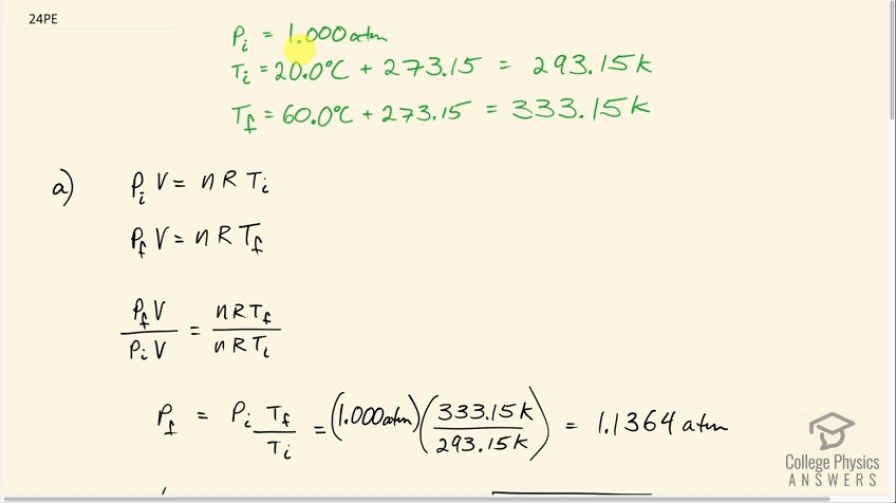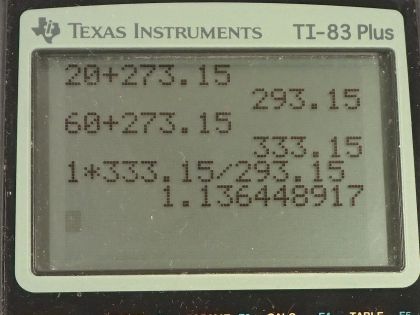Question
Suppose a gas-filled incandescent light bulb is manufactured so that the gas inside the bulb is at atmospheric pressure when the bulb has a temperature of
. (a) Find the gauge pressure inside such a bulb when it is hot, assuming its average temperature is (an approximation) and neglecting any change in volume due to thermal expansion or gas leaks. (b) The actual final pressure for the light bulb will be less than calculated in part (a) because the glass bulb will expand. What will the actual final pressure be, taking this into account? Is this a negligible difference?
Final Answer
Solution video
OpenStax College Physics for AP® Courses, Chapter 13, Problem 24 (Problems & Exercises)

vote with a rating of
votes with an average rating of
.
Calculator Screenshots
Video Transcript
This is College Physics Answers with Shaun Dychko. An incandescent light bulb is manufactured such that at 20 degrees Celsius the absolute pressure inside of it is one atmosphere. Now it doesn't tell us how many significant figures to put in this figure of one atmosphere but I'm just going to assume it has lots of precision just because these temperatures are quite precise. And we're going to be answering the same question in two different ways: we're going to be answering the question when the temperature rises up to 60 degrees Celsius what will the gauge pressure inside the bulb be then? And we're going to answer at once ignoring any volume expansion of the glass. And in Part B then we will take into account the fact that the volume of the glass changes and therefore since the glass enclosing the gas expands then the gas itself will also expand to fill that now bigger glass enclosure. And so the difference in pressure in the two cases is very small. And so in order to see that difference we'll need to have lots of precision in our pressure. Okay. Our ideal gas law requires absolute temperature or temperature in kelvin in other words. So we convert 20 degrees Celsius by adding 273.15 to it to get 293.15 kelvin, and likewise for the 60 degrees Celsius becomes 333.15 kelvin. So the initial pressure in the bulb at 20 degrees Celsius which is the initial temperature, initial pressure times the volume equals the number of moles of gas inside times the universal gas constant times the initial temperature. And there's no subscript on the volume because we assume in this question part A that the volume is constant, and so there's no need for an I or an F here. You'll see that in Part B we do need to put subscripts for the volume but in this case no, not right now. The number of moles will stay the same because there's no gas escaping or coming in and this is just the constant that's always R. And we do have subscripts on the temperature because there are different temperatures in each scenario: 20 degrees Celsius in the beginning and 60 degree Celsius in the end although we're going to write these as absolute temperatures in kelvin in here. So we're going to solve for final pressure. So we'll take the left-hand side of these two equations and divide them. So PFV over PIV and then take the right-hand side of the equation and also divide those. So NRTF divided by NRTI. We have a whole bunch of common factors that cancel. We multiply both sides by initial pressure and then we get the final pressure then as the initial pressure multiplied by the final temperature divided by the initial temperature. So that's 1.000 atmospheres multiplied by the final temperature of 333.15 kelvin divided by the initial temperature of 293.15 kelvin, and that is 1.1364 atmospheres. Now this is an absolute pressure because that's what we always get in this ideal gas formula. And the question is asking us though for the gauge pressure. So I'm indicating gauge pressure with this prime symbol. And so the final pressure in gauge terms which is another way of saying the amount by which the pressure exceeds atmospheric pressure that's what gauge pressure is, so we take this absolute pressure that we found and subtract away an atmosphere and we get zero point one three six atmospheres is the gauge pressure. Then in Part B we answer the same question again: what will the final pressure in the bulb be when it rises from 20 degrees Celsius to 60 degrees Celsius? But we're going to assume that the glass of the bulb expands. So here's the bulb and it's going to become a little bit bigger as its temperature increases. Now of course this is drawing, it's not to scale but I'm just trying to illustrate the idea. So this is at initial temperature of 20 degrees Celsius and this is at the final temperature of 60 degrees Celsius, it's going to be a bigger enclosure. So the volume of the gas is going to change then. So we need a subscript on the volume now. So there's an initial volume and then there's a final volume. The number of moles stays the same though so it does not need a subscript still because it's the same number of gas molecules inside. And so we divide the two sides of the equation just like we did before. So we have PFVF over PIVI equals NRTF over NRTI. And the N R is a common factor that cancels. And we're solving for PF by multiplying both sides by P initial times volume initial divided by volume final. And we have then the final pressure is the initial pressure times the initial volume divided by the final volume multiplied by the final temperature divided by the initial temperature. So the final volume will be the initial volume plus however much the bulb expands. And this expansion, this thermal expansion is given by the coefficient of volume expansion multiplied by the initial volume times the change in temperature. And so this is the coefficient of volume expansion for glass that we're interested in. So we have the initial volume plus beta V I delta T and this delta T is T final minus T initial. So then all of this here gets substituted in place of V F in our final pressure formula, and that's what I show here. So P final then is P initial times V I over V I plus beta V I times T F minus T I times T F over T I. Now this V I is a common factor on the top and bottom. It's a common factor among both the terms on the bottom. So it factors out and then cancels with the V Ion the top. So, on the top you just get the number 1 in other words. So we have P I over 1 plus beta times T F minus T I times T F over T I. And so we have one atmosphere initial pressure divided by 1 plus 20 times 10 to the -6 per Celsius degree - coefficient of volume expansion for ordinary glass - times 333.15 kelvin minus 293.15 kelvin times the final temperature divided by the initial temperature, and we get 1.1352 atmospheres. Now that's absolute pressure. And then finding gauge pressure means subtracting atmosphere from it. So we get 0.135 atmospheres. And now we find the percent difference between this scenario where we do account for the volume expansion of the glass versus Part A where we did not account for it. So we had an answer of 0.1364 without accounting for the expansion minus 0.135 when we do account for it and divide by that number there, and we get a point nine percent difference and that difference is negligible.

